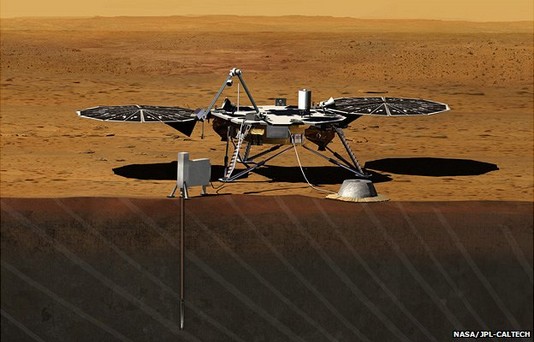Just two weeks after landing its Curiosity rover on Mars, the US space agency has announced it will send another robot to the planet in 2016.
The InSight spacecraft will be a static lander that will carry instruments to investigate Mars’ deep interior.
Scientists say this will give them a clearer idea of how the rocky planets formed – the Earth included.
InSight beat two other proposals in a competition to find Nasa’s next relatively low-cost mission.
This so-called Discovery class of endeavour is cost-capped at $425m (£270m; 345m euros), although that figure does not include the rocket to launch the spacecraft.
InSight stands for Interior Exploration using Seismic Investigations, Geodesy and Heat Transport.
It will be led from the Jet Propulsion Laboratory (JPL) in Pasadena, California.
The design of the lander leans heavily on the successful Phoenix probe put on the Red Planet in 2008. But although the 2016 venture will look very similar, it will carry very different instrumentation.
A seismic experiment will listen for “marsquakes” and use this information to map the boundaries between the rock layers inside Earth’s neighbour.
It will determine if the planet has a liquid or solid core, and provide some clues as to why its surface is not divided up into tectonic plates as on Earth.
Key components of this package will come from France and the UK.
InSight will also push a German-built thermal probe into the surface to gauge Mars’ temperature profile. This will reveal how the planet is cooling.
JPL will provide the two cameras on InSight and a robotic arm.
It will also deliver another sensor that will very accurately determine the degree to which the planet wobbles on its axis.
All the data combined will inform researchers about the internal state of Mars today and how it has changed through the eons.
“This is science that has been compelling for many years,” said John Grunsfeld, who heads up Nasa’s science division.
“Seismology, for instance, is the standard method by which we’ve learned to understand the interior of the Earth – and we have no such knowledge for Mars.
“This has been something the principal investigator (JPL’s Bruce Banerdt) of this mission has been trying to get to Mars for nearly three decades, and so I’m really thrilled that this is now at a mature stage where he has been able to propose something that fits within the cost and schedule constraints of the Discovery programme.”
It is clear from surface features that the Red Planet was much more geologically active in the past. The remains of the largest volcano in the Solar System – Olympus Mons – can be seen on Mars.
When and why this activity waned remains to be established, but it is an issue that plays directly to the question of life on the planet.
Earth retains an atmosphere and water at its surface because of the protective magnetic field generated in its liquid iron/nickel core.
At some point, Mars lost its global magnetic shield and that allowed the stream of particles billowing away from the Sun – the “solar wind” – to strip away the planet’s atmosphere, leading to the loss also of its surface water. This change may have stifled any chance for life to establish itself on Mars.
Tom Pike from Imperial College London, UK, will be working on the mission.
He told BBC News: “This is not going to be a mission of pretty pictures like Curiosity, but when we get the first marsquakes I think that is going to be a really cool data set.
“We’ll be doing comparative planetology. We know the internal structure of the Earth, but we have nothing to compare it with.
“We don’t know if Earth is a special case or a more general case. A lot of science is based on it being a more general case because that allows you to develop theories about how the core formed, the mantle around it and then the crust on top. But we’d really like to test this out on another planet.
“InSight will enable us to do that Mars.”
Nasa is currently basking in the success of its Curiosity rover, which landed on the planet two weeks ago. That mission, by comparison, is costing $2.5bn (£1.6bn; 2bn euros).
The space agency says the InSight selection was made before the six-wheeled vehicle touched down and so was not influenced in any way by recent events.
The outlook for American Mars scientists now looks considerably brighter than it did at the beginning of the year.
Back in February, they were told Nasa’s budget for Red Planet exploration would be cut back sharply; and many feared that if Curiosity was lost during its risky landing, they might not see another US-led Martian lander for perhaps 10 years.
The two missions that missed out in the final Discovery selection were:
Titan Mare Explorer – Billed as the first direct exploration of an ocean environment beyond Earth. This would put a “boat” on a large methane-ethane sea on Saturn’s moon Titan.
Comet Hopper – This would study cometary evolution by landing on a comet multiple times and observing its changes as it interacted with the Sun.






